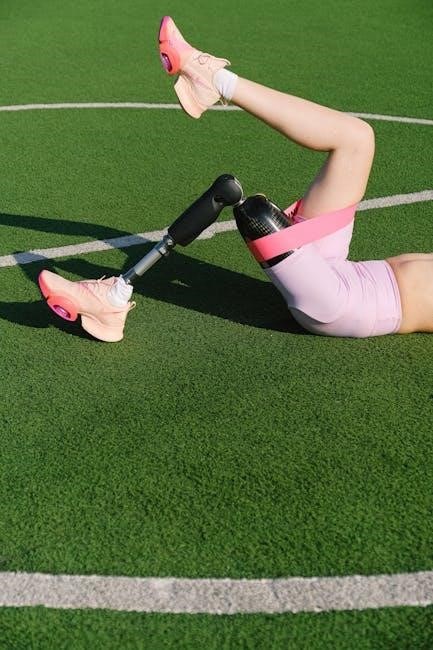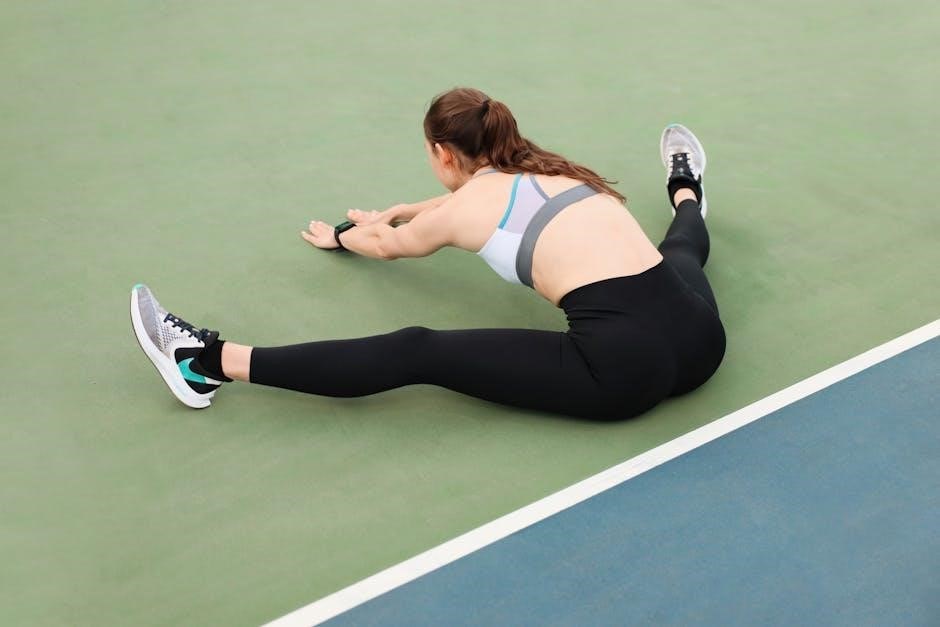IT Band Syndrome is a common injury among athletes and runners, causing pain on the outside of the knee. This section provides essential exercises for recovery and prevention.
1.1 What is IT Band Syndrome?
IT Band Syndrome, or iliotibial band syndrome, is a common overuse injury causing pain on the outside of the knee. It occurs when the iliotibial band, a ligament running down the thigh, becomes inflamed or irritated. This condition is often seen in runners, cyclists, and athletes who engage in repetitive knee-bending activities. Proper exercises and stretching can help alleviate symptoms and promote recovery.
1.2 Common Causes and Risk Factors
IT Band Syndrome often arises from repetitive activities like running or cycling, leading to inflammation of the iliotibial band. Risk factors include poor training techniques, sudden increases in activity, weak hip muscles, and improper footwear. These causes can result in friction and irritation of the IT band, causing pain and discomfort during movement.
1.3 Symptoms and Diagnosis
IT Band Syndrome typically causes pain on the outside of the knee, especially during activities like running or cycling. Swelling and tenderness near the knee may also occur. Diagnosis involves a physical exam, reviewing symptoms, and sometimes imaging tests like MRI or ultrasound to confirm inflammation or irritation of the IT band. Early detection is crucial for effective treatment and recovery.
Understanding the IT Band
The IT Band is a ligament running down the thigh, supporting the knee and stabilizing the leg during movement. It plays a crucial role in physical activities like running and cycling.
2.1 Anatomy of the IT Band
The IT Band, or iliotibial band, is a thick ligament extending from the iliac crest down the thigh to the tibia. It stabilizes the knee and aids in leg movement. Composed of dense connective tissue, it runs parallel to the femur and plays a key role in activities like running and cycling. Its structure allows it to absorb shock and provide lateral support during physical activities.
2.2 Function and Importance
The IT Band plays a crucial role in stabilizing the knee during movements like running or cycling. It facilitates smooth thigh and knee motion, reducing friction between muscles and bones. Its tensile strength provides lateral stability, essential for athletes and individuals with repetitive knee movements. Understanding its function is vital for preventing injuries and developing effective rehabilitation strategies, as outlined in IT Band Syndrome exercise guides.
2.3 Common Injuries and Overuse
The IT Band is prone to injuries, particularly from overuse, leading to IT Band Syndrome. Repetitive stress from activities like running or cycling causes inflammation and pain. Overuse injuries often result from sudden increases in activity or improper training techniques. Ignoring early symptoms can worsen the condition, making recovery more challenging. Addressing these issues early is crucial for effective rehabilitation and preventing long-term damage.

Stretching Exercises for IT Band Syndrome
Stretching exercises are essential for alleviating IT Band Syndrome symptoms. They improve flexibility, reduce tension, and promote recovery. Regular stretching can help prevent future injuries and enhance mobility.
3.1 Standing IT Band Stretch
The standing IT Band stretch targets the iliotibial band, reducing tension and improving flexibility. Stand with feet shoulder-width apart, then cross one leg over the other. Bend the knee of the crossed leg slightly and lean toward the opposite side until a gentle stretch is felt. Hold for 20-30 seconds and repeat on both sides. This stretch is ideal for pre- or post-workout routines to enhance mobility and prevent tightness.
3.2 Lying IT Band Stretch
The lying IT Band stretch is an effective way to relieve tension in the iliotibial band while minimizing strain on the knee. Lie on your side with legs extended, then bend the top knee toward your chest. Gently pull the knee across your body until a stretch is felt on the outer thigh. Hold for 20-30 seconds and repeat on both sides. This stretch is ideal for post-workout recovery and improving flexibility.
3.3 Hip Flexor Stretching
Hip flexor stretching is crucial for alleviating IT Band tightness, as tight hip flexors can contribute to IT Band strain. Start on your hands and knees, then bring one knee forward and place your foot flat on the ground in front of the other knee. Lean forward slightly, stretching the front of your hip. Hold for 20-30 seconds and switch sides. This stretch improves hip mobility and reduces IT Band tension effectively.

Strengthening Exercises
Strengthening exercises target the glutes, core, and legs to support the IT Band and prevent strain. These exercises enhance stability and promote long-term injury prevention.
4.1 Glute Strengthening Exercises
Glute strengthening exercises are crucial for IT Band Syndrome recovery. Weak glutes can lead to poor hip alignment, increasing IT Band strain. Effective exercises include clamshells, side-lying leg lifts, and glute bridges. These movements help stabilize the hips and pelvis, reducing pressure on the IT Band. Incorporating these exercises into your routine can improve running mechanics and prevent future injuries.
4.2 Core Strengthening for Stability
Core strengthening exercises are vital for improving stability and reducing IT Band strain. A strong core enhances pelvic alignment, minimizing lateral knee stress. Exercises like planks, bird dogs, and side planks target abdominal and lower back muscles. These movements promote better biomechanics during activities, reducing the risk of IT Band irritation and improving overall athletic performance.
4.3 Leg Strengthening Exercises
Leg strengthening exercises are essential for IT Band recovery. Weakness in the quadriceps, hamstrings, and calves can contribute to strain. Squats, lunges, and leg presses target these muscle groups, improving knee stability. Strengthening the legs helps redistribute force away from the IT Band, reducing inflammation and pain during activities like running or cycling. Consistent practice enhances muscle balance and supports long-term recovery.

Foam Rolling Techniques
Foam rolling reduces muscle tension and improves circulation. Focus on the quads, hamstrings, and IT Band. Roll in one direction to avoid irritation. Regular use aids recovery.
5.1 Foam Rolling the IT Band
Foam rolling the IT Band targets the outer thigh, reducing tension and inflammation. Lie on your side with the roller under your thigh. Slowly roll from the hip to the knee, applying moderate pressure. Focus on tender areas but avoid painful pressure. Repeat for 2-3 minutes, breathing deeply to relax. This technique improves circulation and flexibility, aiding recovery and preventing IT Band Syndrome.
5.2 Foam Rolling the Quads and Hamstrings
Foam rolling the quads and hamstrings targets muscle tension in the thighs. Start by rolling the quads, moving from the top of the thigh to the knee. Then, roll the hamstrings from the knee to the glutes. Use slow, controlled movements, applying moderate pressure. This helps reduce muscle tightness, improves circulation, and complements IT Band recovery. Regular rolling can prevent imbalances and enhance overall lower limb flexibility and strength.
5.3 Foam Rolling for Recovery
Foam rolling is a key recovery tool for IT Band Syndrome, reducing muscle soreness and improving circulation. Focus on slow, controlled movements, spending extra time on tight areas. Regular foam rolling helps alleviate tension, promotes healing, and enhances flexibility. Consistency is crucial for long-term benefits, making it an essential part of any recovery routine for athletes and individuals with IT Band discomfort.

Dynamic Stretching and Warm-Up
Dynamic stretching and warm-up routines are essential for preventing IT Band Syndrome; They improve flexibility, reduce muscle tension, and prepare the body for physical activity, lowering injury risk.
6.1 Pre-Workout Dynamic Stretching
Pre-workout dynamic stretching is essential for activating muscles and improving flexibility. Focus on leg swings, high knees, and lateral lunges to target the IT band and surrounding tissues. These exercises enhance blood flow, reduce muscle stiffness, and prepare the body for activity, lowering the risk of IT Band Syndrome. Consistent practice ensures better mobility and injury prevention, making it a crucial part of any workout routine.
6.2 Post-Workout Cool-Down Routines
Post-workout cool-down routines aid in muscle recovery and reduce stiffness. Gentle stretches, such as seated forward bends and calf stretches, help relax the IT band. Incorporating foam rolling and static stretches for 20-30 seconds each targets tight areas. This practice promotes blood flow, prevents soreness, and supports overall muscle health, making it vital for maintaining flexibility and preventing IT Band Syndrome after intense activities.
6.3 High-Knee Drills and Leg Swings
High-knee drills and leg swings are dynamic exercises that improve flexibility and strength. High knees involve lifting knees toward the chest while running in place, enhancing hip mobility. Leg swings, both forward-backward and side-to-side, stretch the hips and IT band. These drills prevent stiffness, improve range of motion, and are particularly beneficial for runners and cyclists. Incorporate them into your routine to maintain IT band health and performance.

Preventing IT Band Syndrome
Preventing IT Band Syndrome involves proper warm-ups, gradual activity increases, and wearing supportive footwear. Strengthening hip and core muscles also helps reduce the risk of injury.
7.1 Proper Running and Cycling Techniques
Proper running and cycling techniques are crucial for preventing IT Band Syndrome. Maintaining a balanced posture, avoiding overstriding, and using correct gear can reduce strain. Cyclists should ensure proper bike fit, while runners should focus on midfoot striking. Incorporating strength training and regular stretching can further enhance performance and minimize injury risk. Consistency and form are key to long-term prevention.
7.2 Wearing the Right Gear
Wearing the right gear is essential for preventing IT Band Syndrome. Runners should opt for supportive shoes with proper arch support and cushioning. Cyclists benefit from padded shorts and correctly fitted bikes. Using compression sleeves or IT band braces can reduce friction and provide stability. Ensuring footwear is replaced regularly and avoiding worn-out gear helps minimize repetitive strain on the IT band, promoting long-term comfort and performance.
7.3 Gradual Increase in Activity
A gradual increase in activity is crucial to prevent IT Band Syndrome. Sudden spikes in running or cycling mileage can overload the IT band, leading to inflammation. Athletes should aim for a slow, progressive buildup of distance and intensity, allowing the body time to adapt. Incorporating rest days and cross-training can help reduce repetitive stress. Monitoring for early signs of strain and adjusting training volumes accordingly is essential for long-term health and performance.

Advanced Rehabilitation Techniques
Advanced techniques include physical therapy exercises, eccentric strengthening, and balance training to restore function and strength, addressing IT Band Syndrome effectively for long-term recovery and stability.
8.1 Physical Therapy Exercises
Physical therapy exercises for IT Band Syndrome focus on improving knee mobility and strengthening surrounding muscles. Techniques include step-ups, mini-squats, and lateral walks to enhance stability. These exercises, often detailed in PDF guides, are designed to reduce inflammation and restore proper movement patterns, ensuring a comprehensive recovery plan tailored to individual needs.
8.2 Eccentric Strengthening
Eccentric strengthening focuses on lengthening muscle contractions to build tendon resilience, crucial for IT Band Syndrome recovery. Exercises like heel drops or controlled descents target the affected area, improving strength and flexibility. These routines, often outlined in PDF guides, emphasize gradual progression to avoid overloading the tendon, ensuring sustainable healing and long-term durability for athletes and runners.
8.3 Balance and Proprioception Training
Balance and proprioception training enhances stability and muscle coordination, crucial for IT Band Syndrome recovery. Exercises like single-leg stands, wobble board drills, and balance pads improve joint stability and reduce injury risk. These routines, often detailed in PDF guides, focus on rebuilding the body’s awareness to maintain proper movement patterns during physical activities, promoting long-term stability and preventing recurrence of the syndrome.

Nutrition and Recovery
Nutrition plays a vital role in recovery from IT Band Syndrome. Focus on anti-inflammatory foods, adequate hydration, and protein-rich diets to support tissue repair and reduce inflammation.
9.1 Importance of Protein and Collagen
Protein and collagen are essential for tissue repair and strength. Collagen supports connective tissues like the IT band, while protein aids in muscle recovery. Incorporating collagen supplements and protein-rich foods like lean meats, fish, and eggs can enhance healing. Proper nutrition accelerates recovery and helps prevent future injuries, making it a cornerstone of IT band syndrome management.
9.2 Anti-Inflammatory Diets
An anti-inflammatory diet is crucial for managing IT band syndrome. Focus on consuming omega-3 rich foods like fish, nuts, and seeds to reduce inflammation. Incorporate antioxidants from fruits and vegetables, such as berries and leafy greens. Whole grains and lean proteins also support healing. Avoid processed foods, sugary drinks, and excessive alcohol. Staying hydrated and considering supplements like turmeric or ginger can further aid in reducing inflammation and promoting recovery.
9.3 Hydration and Electrolytes
Proper hydration and electrolyte balance are vital for muscle function and recovery. Drinking plenty of water helps maintain tissue flexibility, reducing the risk of IT band friction. Electrolytes like sodium and potassium support nerve function and muscle contractions. Incorporate electrolyte-rich foods such as bananas, nuts, and avocados into your diet. Sports drinks can replenish lost salts during intense workouts, ensuring optimal hydration levels for healing and performance.

Tools and Resources
Downloadable PDF guides provide structured exercise plans for IT band recovery. Mobile apps track progress, while foam rollers and resistance bands are essential rehab tools.
10.1 IT Band Syndrome Exercise PDF Guides
These comprehensive PDF guides offer detailed exercise routines, stretching techniques, and strengthening programs for IT band recovery. They include visual diagrams, step-by-step instructions, and progress tracking tools. Ideal for athletes and physical therapists, these guides provide structured plans to alleviate pain and prevent future injuries. Accessible and downloadable, they serve as a valuable resource for effective rehabilitation and long-term maintenance of knee health.
10.2 Mobile Apps for Tracking Progress
Mobile apps like JEFIT and Fitstar offer customizable workout plans and progress tracking for IT band recovery. These apps provide guided exercises, injury-specific routines, and personalized goals. They enable users to monitor their progress, set reminders, and access nutritional advice. Such tools empower individuals to stay consistent with their rehabilitation journey, ensuring long-term recovery and preventing future injuries effectively.
10.3 Recommended Equipment for Rehab
Essential equipment for IT band rehab includes foam rollers, resistance bands, and exercise mats. Foam rollers help with self-myofascial release, reducing tension in the IT band. Resistance bands provide gentle resistance for strengthening exercises. Exercise mats offer comfort and support during floor-based stretches. These tools are cost-effective and portable, making them ideal for both home and gym-based rehabilitation programs.

Success Stories and Case Studies
Real-life recovery journeys of athletes overcoming IT Band Syndrome inspire others. Their success stories highlight effective exercises and gradual progress, offering practical advice for full recovery.
11.1 Athletes Who Overcame IT Band Syndrome
Many professional athletes have successfully recovered from IT Band Syndrome by adhering to structured exercise routines. Their inspiring stories highlight the importance of consistent stretching, strengthening, and proper rehabilitation techniques. These athletes exemplify how dedication and the right approach can lead to a full recovery, enabling them to return to peak performance and achieve new heights in their respective sports.
11.2 Real-Life Recovery Journeys
Real-life recovery journeys highlight individuals who successfully overcame IT Band Syndrome through structured exercise routines. Runners, cyclists, and athletes share their personal struggles and triumphs, detailing how they incorporated stretching, strengthening, and foam rolling into their daily routines. Their stories emphasize the importance of consistency, patience, and the right exercises in achieving a full recovery and returning to active lifestyles.
11.3 Lessons Learned from Common Mistakes
Understanding common mistakes in IT Band Syndrome recovery is crucial for effective healing. Many individuals overlook proper form during exercises, leading to prolonged recovery. Ignoring pain and inadequate rest are frequent errors. Others may over-rely on a single exercise type, neglecting balance. Seeking professional guidance and ensuring a well-rounded routine combining strength, flexibility, and rest is essential for optimal outcomes.
12.1 Summary of Key Exercises and Tips
Key exercises include standing and lying IT band stretches, glute strengthening, and foam rolling. Dynamic stretches before workouts and proper warm-ups are essential. Avoid overtraining, gradually increase activity, and maintain consistent stretching routines. Incorporate core stability exercises for overall lower body strength. Prioritize recovery with foam rolling and rest. These tips, combined with patience, promote long-term relief and prevention of IT band syndrome.
12.2 Long-Term Maintenance and Prevention
For long-term maintenance, incorporate regular stretching, strengthening exercises, and proper warm-ups into your routine. Monitor training loads and avoid overtraining. Wear appropriate footwear and gradually increase activity levels. Maintain a healthy weight to reduce strain on the IT band. Foam rolling and consistent recovery practices help prevent recurrence. Focus on glute and core strength for stability, ensuring long-term health and functionality of the IT band.
12.3 Final Thoughts on Recovery
Recovery from IT Band Syndrome requires patience, consistency, and a holistic approach. Incorporate stretching, strengthening, and proper warm-up routines into your daily regimen. Avoid overtraining and focus on maintaining proper form during exercises. Over time, this dedication will lead to long-term relief and prevention of recurrence, ensuring optimal knee health and functionality for years to come.
